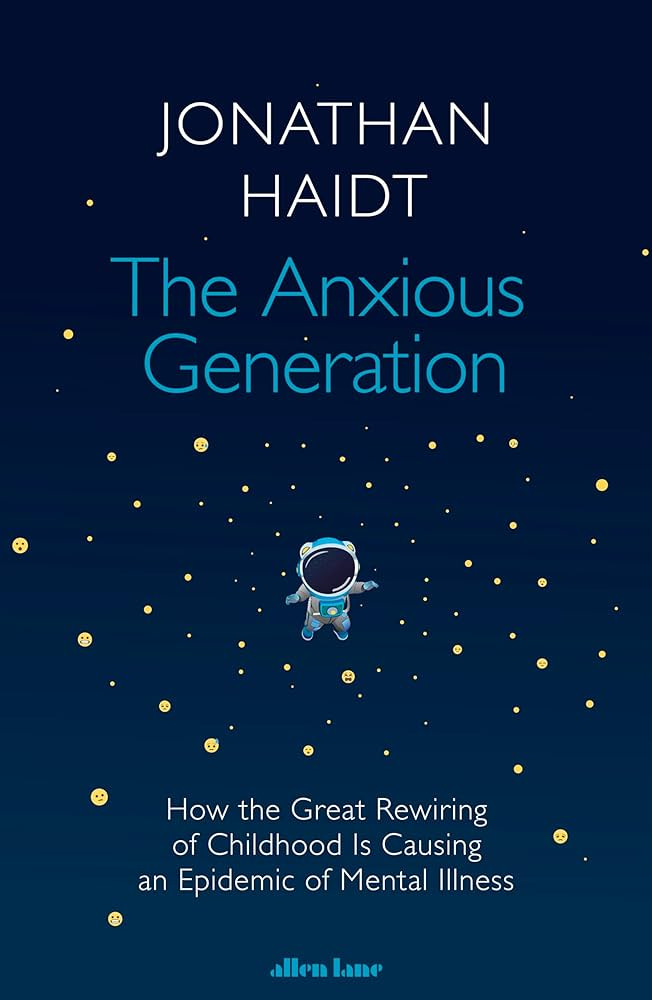Statistics can be manipulated to fit an agenda, but these particular ones are hard to argue with. Between 2010 and 2015, the teenage suicide rate in the USA, amongst both boys and girls, rose dramatically. At around the same time, the percentage of teens reporting that they feel they have no chance of achieving “success” in their lives plummeted. Again, during roughly the same years, the proportion of teenagers getting below 7 hours of sleep per night skyrocketed. And, once again, during that same 5 year period, diagnoses and self-reports of anxiety amongst adolescents went up. Interestingly, the usage of social media on smartphones increased exponentially during exactly the same time. These are the observations at the heart of Jonathan Haidt’s sobering The Anxious Generation — and as you might guess, his central argument is that our children’s woes and their increased use of smartphones aren’t unrelated. Indeed, he asserts — in pretty convincing fashion — that the latter are a cause of the former.
The evidence he uses to support his case is wide-ranging and convincing. As you might expect, there’s too much of it to present here in any great detail, but essentially, Haidt’s stand is that the designers of smartphone-based social media apps (he is at pains to point out that pre-smartphone iterations of Facebook et al were quite different beasts and not nearly as damaging as today’s incarnations) actively manipulate the human brain’s innate need for gratification. This is difficult enough to combat when you’re a relatively well-balanced adult whose childhood did not involve spending endless hours on mobiles. It’s almost impossible to fight when you’re a thirteen year old whose brain is still developing and whose entire world appears to revolve around the ‘acceptance-rejection’ feedback loops engendered by likes, shares and comments.
Add to this the fact that since the 1980s, parenting has become more protective - ‘safetyism’ is a term coined by the author - and that children aren’t encouraged to engage in supportively risky, exploratory play, and you have a situation in which the smartphone is the companion teens inevitably turn to for companionship, stimulation and affirmation. The irony, says Haidt, is that we’ve taken them away from playgrounds that weren’t really all that unsafe and plunged them into a virtual world that couldn’t be more dangerous.
Critics of his book claim that Haidt has put 2 and 2 together and made 5: in other words, that he hasn’t shown a sufficiently strong causal link between the usage of smartphones and the social ills he describes. Others have complained that laying the blame for today’s problems on just one factor is too simplistic a take on the situation. However, even some of the tome’s detractors have praised The Anxious Generation for successfully generating a debate about issues that urgently require our attention, as well as for attempting to force legislators to consider our teenagers’ problems at a real-world, policy level. Regardless of whether one ends up agreeing with the entirety of its content, the book is an absolute must-read for anyone with even a passing interest in the welfare of young people. Accessible, lucid and measured, it strikes a note of considerable alarm while giving the reader hope that it is not too late to rescue our youngsters from a fate determined by this most pervasive and invidious of technologies.
At one point in the book, Haidt likens the current situation with smartphones to the scenario we had in the past when smoking was deemed socially acceptable, even though there was plenty of evidence to show how much damage it was causing. The smartphone is today’s cigarette, and if The Anxious Generation is to be believed, future teens will be grateful to us if we take action now to limit its usage. Certainly, the Australian government seems to be taking the matter very seriously indeed. One imagines that Haidt would praise their work and hope that other countries will follow suit.
Dariush






A fantastic take on this book. Measured and nuanced as it deserves for a hot topic that nevertheless requires a lot more attention by parents, regulators, technologists and society at large.
Having two adolescent sons of my own and two bonusdaughters, I am very interested in this book. And I just found and got this book in the Dutch translation. Thanx for the review!